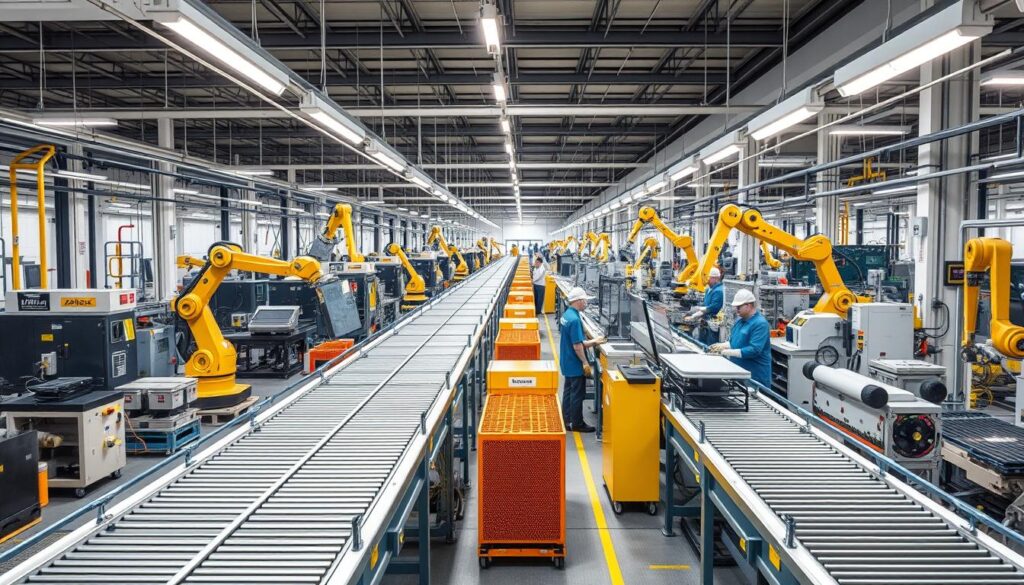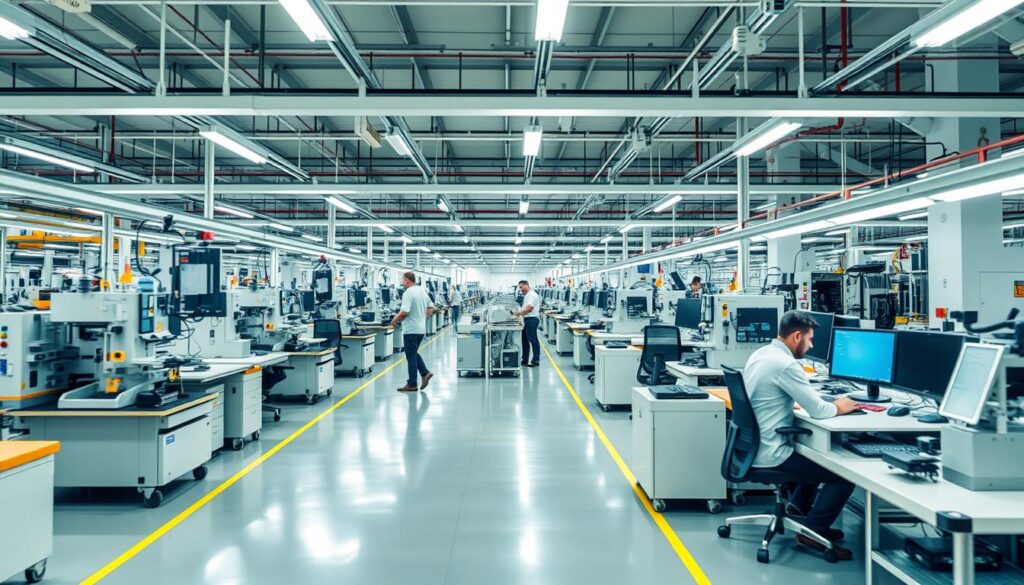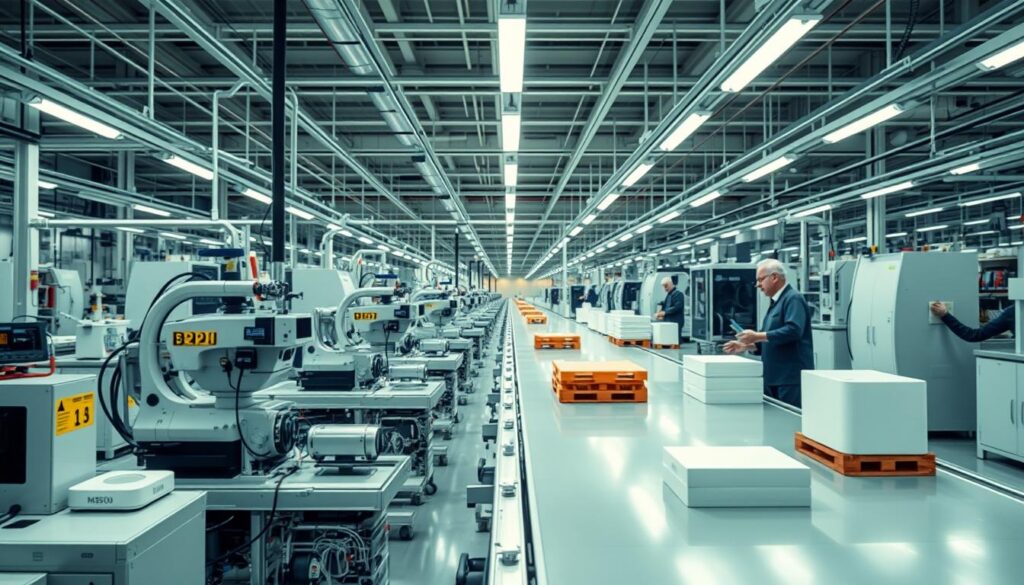In the fast-moving world of manufacturing, the aim to optimize production line efficiency shows a company’s dedication to being the best. It’s all about making better products quicker and using fewer resources. This is key for any business wanting to improve how their factory works.
Having an efficient production line is like having the heart of a successful manufacturing business. It beats with productivity and saves money. This guide offers tips and strategies for today’s manufacturing needs. We’ll look at important KPIs, check how efficient things are now, find out what might be making things slow, and see how to make manufacturing and assembly faster.
Key Takeaways
- Understanding Overall Equipment Effectiveness (OEE) is vital for better production efficiency.
- Keeping an eye on Work-in-Progress (WIP) quantity helps spot workflow issues.
- A high defect rate percentage points out problems that, when fixed, can improve quality.
- A good throughput rate shows the line meets deadlines at full capacity.
- Looking at cycle time and takt time shows if production speed needs changes to meet demands.
- Real-time monitoring and visual tools give instant info for quick improvements.
- Business automation and data integration services boost quality control, maintenance, and line efficiency.
Understanding Production Line Efficiency
To improve manufacturing productivity and maximize manufacturing line output, it’s key to grasp production line efficiency. This idea involves increasing the outputs from any resource input. It’s about keeping a balance between quality and speed while cutting down waste and costs.
Definition of Production Efficiency
Production efficiency looks at the output versus input ratio of a manufacturing line. It shows how well resources are used to get the best results. This includes the amount of products, their quality, and how consistently they are made.
Importance of Efficiency in Manufacturing
Higher efficiency in manufacturing is linked to better competitiveness, profits, and customer happiness. Efficient production lines use fewer resources and make less waste. This makes operations more sustainable.
Key Metrics for Measuring Efficiency
Various metrics help in optimizing workflow efficiency. These metrics are:
- Overall Equipment Effectiveness (OEE)
- Work-in-Progress (WIP)
- Defect Rate
- Throughput
- Cycle Time
- Takt Time
Here’s a closer look at some of these metrics. They show their role in boosting production line efficiency and output:
| Metric | Description | Impact on Efficiency |
|---|---|---|
| Overall Equipment Effectiveness (OEE) | Measures three critical performance areas: Availability, Performance, and Quality. | This is tied to productive manufacturing time. A 85% target is seen as world-class. |
| Yield Rate | Shows the ratio of good units to total produced units. | A high yield means fewer defects and better output quality. |
| Cycle Time | Times how long it takes to make a unit from start to finish. | Lower cycle times improve throughput and reduce waste. |
Understanding and using these metrics can greatly change production lines. They become not just more efficient but also better suited to meet the competitive demands of manufacturing.
Identifying Bottlenecks in Your Production Line
Bottlenecks can really slow down production lines. They make it hard to make things faster and better. Let’s figure out how to spot and fix these bottlenecks to keep things moving smoothly.
Common Types of Bottlenecks
Many things can cause bottlenecks. It could be machines breaking down, not having enough people, or steps that just take too long. A common problem is when one part of the line gets too much work. This creates delays and pile-ups. Tesla had trouble making custom batteries fast enough. To solve this, they built the Gigafactory to increase production.
Tools for Identifying Bottlenecks
Spotting bottlenecks takes a careful approach. You can map out each step, ask “why” questions to get to the root of issues, and look for signs of trouble. This could be inventory stacking up or people waiting around. By comparing what is happening to what should happen, businesses can find where the line slows down.
Case Studies of Bottleneck Resolution
Making changes based on what you find can really help. Fixing workflow problems has helped companies work more smoothly. Using real-time data and listening to workers helps find good solutions.
| Issue | Tool/Solution | Outcome |
|---|---|---|
| Equipment Breakdown | Regular Maintenance Schedule | Reduced Downtime |
| Staff Shortage | Training & Hiring | Increased Capacity |
| Inefficient Process | Process Re-engineering | Improved Flow Efficiency |
| Quality Issues | Quality Assurance Protocols | Higher Product Quality |
| Overcapacity | Capacity Adjustment | Balance Production Line |
Getting rid of bottlenecks helps everything run smoother. It also helps meet goals and make more money. Using the right tools and tactics to find and fix bottlenecks means making things much better. This leads to streamlined assembly processes.

Implementing Lean Manufacturing Principles
In today’s competitive manufacturing world, it’s key to optimize production line efficiency and increase operational output. Lean manufacturing principles provide a roadmap for achieving these goals. They came from the Toyota Production System in the 1950s and help reduce waste while boosting productivity.
Core Principles of Lean Manufacturing
Lean manufacturing is based on core principles that boost efficiency by cutting out pointless tasks. Tools like value stream mapping, Just-In-Time (JIT) production, and the 5S methodology are central. Value Stream Mapping (VSM) is essential. It shows the whole production process, identifies waste, and spots opportunities for improvement.
Just-In-Time production minimizes waste by ensuring parts are made and supplied only when needed. The 5S methodology — Sort, Set in order, Shine, Standardize, Sustain — makes workspaces neat. This saves time searching for tools and boosts safety and effectiveness.
Benefits of Lean Practices
Using lean principles improves production line work. Standardized work processes and pull-based production raise product quality efficiently. This can cut production costs by up to 35% in some industries. It also keeps inventory at just the right level which increases operational output.
Lean practices encourage ongoing improvement. They get staff involved in fixing problems and improving processes. This not only makes employees happier but also makes sure gains last long-term. It keeps making operations better and more productive.
Real-World Examples of Lean Success
Companies in various sectors have seen big benefits from lean principles. Toyota greatly lowered costs in jet engine part manufacturing. Also, using methods like the 5S, firms have cut lead times and bettered inventory management—even in small businesses.
Total Productive Maintenance (TPM) focuses on getting the most from equipment. Having all employees help with maintenance has lowered downtime. It’s also boosted morale and operational efficiency.
In conclusion, as markets change, old production ways are being questioned. Using lean manufacturing principles is a smart move for those aiming to optimize production line efficiency and increase operational output. It ensures long-term success and competitiveness in today’s industry.
Role of Technology in Enhancing Efficiency
Industries are working hard to make factories better and more efficient. They do this by using new technologies. Automation, software solutions, and data analytics play a big role. They help modernize production to increase efficiency and productivity.
Automation and Robotics
Using automation and robotics is key to making production more efficient. Robots are great at doing the same task over and over. They work fast and make fewer mistakes. This leads to a smoother and quicker production process.
Software Solutions for Monitoring
Advanced software helps monitor and manage manufacturing in real-time. It improves communication and makes things more transparent. It also uses resources better. These software solutions are essential in today’s factories.
Data Analytics for Production Insights
Data analytics gives manufacturers deep insights into their production. They analyze data to predict maintenance and reduce downtimes. This keeps production going smoothly and improves quality control.
| Technology | Impact on Efficiency | Benefit to Production Output |
|---|---|---|
| Automation and Robotics | Reduces errors, increases speed | Enhances productivity and reliability |
| Real-time Monitoring Software | Improves process transparency, optimizes resource use | Streamlines operations, minimizes waste |
| Data Analytics | Enables predictive maintenance, optimizes quality control | Fosters informed decision-making, reduces downtime |
These advanced technologies boost factory performance significantly. By combining automation, software, and analytics, continuous improvement becomes a reality. This leads to a more efficient and competitive manufacturing world.
Training and Development for Employees
In today’s manufacturing world, improving productivity is crucial. A good training program is essential. It helps workers handle production pressures better.
Importance of Skilled Workforce
Manufacturers with high OEE scores show how key a skilled workforce is. World-class manufacturers, with scores of 85 percent, focus a lot on employee development. High scores mean top performance and little downtime, thanks to strong training that boosts skills and efficiency.
Effective Training Programs
Great training for manufacturing mixes eLearning with hands-on experience. It aims to boost workplace skills. Adopting well-rounded training programs can mean big financial gains for businesses. Employees become more skilled, which can lead to a 218% rise in income per employee and a 24% increase in profits.
Continuous Learning Opportunities
Embracing ongoing learning keeps factories top-notch. It helps stay up-to-date in a fast-changing industry. By promoting constant learning, companies work better together, improve their workflow, and up production efficiency.
- Blended learning solutions that integrate written materials, videos, webinars, and direct mentorship have proven to be highly effective in embedding valuable skills.
- By focusing on a learner-centric approach, training programs can be customized to individual needs, thereby boosting satisfaction and overall effectiveness.
- Partnerships with established training providers enable businesses to either utilize comprehensive off-the-shelf training solutions or develop bespoke programs suited to specific operational needs.
To wrap up, effective training and development are key for manufacturing success. It not only raises morale and job satisfaction among workers. It also plays a direct part in boosting profits and productivity in today’s competitive manufacturing sector.
Analyzing Workflow and Layout Optimizations
In today’s manufacturing world, being able to streamline assembly process and maximize manufacturing line output is key. A good workflow and smart layout design are vital for success.
Impact of Workflow on Efficiency
An efficient workflow lowers production line problems and cuts delays. By using methods like the Single-Minute Exchange of Dies (SMED), setup times are shortened. This makes it easier to adjust and boosts output.
Best Practices for Layout Design
Using the best design methods makes sure every part of the process is placed right. This saves space and keeps workers safe. With things like vertical storage and modular furniture, space and flow get better. Good layout means smoother assembly and less waste.
Tools for Workflow Assessment
It’s crucial to use advanced tools like CAD and simulations to stay competitive. These tools spot problems and fine-tune operations to maximize manufacturing line output. They mix technology with human work perfectly.
Examining the optimization steps, from looking at product counts to changing layouts, boosts production efficiency. Using Yamazumi charts and conveyors or robots helps reduce unnecessary movement. This saves time.

Involving team members in design decisions builds ownership and teamwork. This improves productivity and efficiency.
| Stage of Process Optimization | Technique Applied | Expected Outcome |
|---|---|---|
| Analyzing Product Quantities | Product vs. Process Matrix | Streamlined Product Families |
| Line Balancing | Yamazumi Charts | Optimized Operator Workflows |
| Physical Layout Changes | Chaku Chaku System | Reduced Movement and Time |
| Material Handling | Automated Systems | Efficient Resource Movement |
| Safety Measures | Ergonomic Equipment | Enhanced Worker Well-being |
By carefully refining workflows and layouts, businesses make big efficiency improvements. This sets them apart in the market, ensuring growth and worker happiness.
Measuring Performance and Productivity
In the competitive world of manufacturing, accurately measuring how well things are done is crucial. It helps make production lines work better. Businesses use different indicators to keep track of and improve how they operate. This lets them understand their production better and make decisions when they need to.
Key Performance Indicators (KPIs)
Overall Equipment Effectiveness (OEE) and Overall Resource Effectiveness (ORE) are key to understanding efficiency. OEE combines how available, how well, and the quality of the work, pointing out issues like equipment failure. On the other hand, ORE looks at things like how efficiently changes are made and if enough workers are available, especially when their skills really affect what’s produced.
Regular Performance Reviews
Having regular check-ups on performance keeps a sharp eye on important metrics. It looks at goals and productivity of machines. Machine productivity is about how much is produced versus what’s used. This includes things like work and materials. Checking on this often can increase productivity by up to 30%.
Adjusting Strategies Based on Data
Changing plans based on data is key to staying ahead. Using insights from various systems and IoT analytics, companies can make smart decisions. This includes managing assets better and planning production. For example, with FREEDOM®AI automation, companies see big improvements by cutting out errors from entering data by hand and making tasks run smoother.
| KPI | Description | Relevance |
|---|---|---|
| OEE (Overall Equipment Effectiveness) | Combines Availability, Performance, and Quality to identify productivity losses | Crucial for automated production lines |
| ORE (Overall Resource Effectiveness) | Incorporates human factors and resource availability | Suitable for labor-intensive production environments |
| Machine Productivity | Measures output per unit of input (time, materials, labor) | Useful for evaluating efficiency improvements post-intervention |
Future Trends in Production Efficiency
Industries are always looking to do better in a tough market. They know it’s crucial to make their production lines work smarter. Future trends in making production more efficient are exciting. They pull from new tech and better ways of doing things. These changes are big; they’re going to shake up manufacturing and set new high scores for doing well.
Industry 4.0 and Smart Factories
Industry 4.0 is at the center of new manufacturing eras. It mixes smart factories with cutting-edge tech like the Internet of Things (IoT), big data, and automation. A study by McKinsey shows a big win for companies using data well. They boosted their output by 18 to 30%. Smart systems offer amazing ways to connect and share data. This leads to smarter choices and the best use of resources with help from ongoing monitoring and predicting needs before they arise.
Sustainable Practices
Being green is also key in making production better. Companies are focusing more on cutting their impact on the planet. This includes less waste and more efficient ways to work. So, caring for the environment is a big part of doing business better. It helps with both making money and looking after our world.
Innovations on the Horizon
There’s always something new coming up in manufacturing. These new things will help improve how materials, processes, and energy are used. This boosts how much can be made. An example is how we calculate production capacity. Emphasizing efficiency means looking closely at output versus input. Keeping an eye on things like Overall Equipment Effectiveness (OEE) gives valuable insights. This ties future trends to ongoing improvements in making production lines better. As these trends grow, they help manufacturers reach new levels of success.
FAQ
What is production line efficiency?
Production line efficiency means how well a line turns inputs into outputs. It focuses on increasing output and quality while lowering waste and costs. This is key for a factory’s performance.
Why is efficiency important in manufacturing?
Efficiency is crucial in making because it affects how cost-effectively a company operates. It ensures resources are well used, products are top-notch, and deliveries are timely. This meets customer needs well.
What are the key metrics for measuring production line efficiency?
Essential metrics include Overall Equipment Effectiveness and Work-in-Progress. Also, defect rates, throughput, cycle time, and takt time are important. These help identify efficiency levels and areas needing work.
What are common types of bottlenecks in production lines?
Bottlenecks often come from delays in supplies, broken equipment, or poor process design. Mistakes by people and not enough resources can also cause bottlenecks. These issues slow down production.
What tools can help identify bottlenecks in production processes?
Tools like LineView help find where production is lagging. They allow for watching operations as they happen. This helps find and fix stages that slow down work or lessen quality.
Can you provide examples of how bottlenecks were resolved in real-world scenarios?
Real examples show that upgrading equipment, redesigning processes, or training staff can fix bottlenecks. This improves flow and reduces idle times.
What are the core principles of lean manufacturing?
Lean manufacturing focuses on making value for the buyer, removing waste, aiming for perfection, and always getting better in production.
How do lean practices benefit manufacturing operations?
Lean practices boost productivity, cut costs, and lessen waste. They make workers happier and more involved. This results in a more agile and leading production system.
Are there real-world examples of successful implementation of lean manufacturing principles?
Yes, many businesses in different fields have shown how using lean principles greatly bettered efficiency, quality, and profit.
How do automation and robotics improve production line efficiency?
Robots and automated systems take over boring, repeat tasks. This ups speed, accuracy, and uniformity in making goods. They help keep factories running all day and night with less stopping and fewer mistakes.
What are the benefits of using software solutions for production monitoring?
Software gives instant data on making processes. This aids in making quick choices, better talking, and planning resources well. It also helps predict when machines might fail and prevents it.
How can data analytics enhance production insights?
Data analytics turns lots of production data into useful tips. This lets makers smooth out processes, spend less, and make better products. It bases decisions on solid facts and future guesses.
Why is a skilled workforce critical for optimizing production line efficiency?
Having skilled workers is key because they handle advanced tech and methods better. This leads to smoother operations and fewer mistakes or accidents at the plant.
What are effective training programs for manufacturing employees?
Good training gives practical hands-on practice with tools and tech used in making goods. It also teaches the latest best ways to do things and safety steps.
How does continuous learning impact production line efficiency?
Constant learning helps workers stay good at dealing with new challenges and tech. This helps keep bettering how things are made, efficiency, and new ideas.
How does workflow impact efficiency?
How work flows affects efficiency by setting how and how smoothly tasks are done. Good workflows cut down needless moves, lower time spent processing, and avoid bottlenecks. This makes the whole making process better.
What are some best practices for layout design in manufacturing?
Good layout design means setting up spaces well for materials to move, keeping transport short, and making sure work areas are clear. It also means placing equipment for the best work and safety.
What tools can assess workflow and guide layout optimizations?
Tools like time-motion studies and layout planning software can check how work flows now and help change layouts to better efficiency.
How should a company use Key Performance Indicators (KPIs) to measure production line efficiency?
A company should keep an eye on KPIs like OEE and how much they’re making to see how efficient they are. This shows what’s working and what needs to be better for making strategy changes.
Why are regular performance reviews important?
Checking performance often is key. It lets businesses know how they’re doing, celebrate wins, see problems, and adjust how they work with changing market needs.
How can adjusting strategies based on data improve manufacturing operations?
Changing plans based on real numbers helps make operations match true performance, customer feedback, and the latest market changes. This leads to smart, forward-thinking management for the best results.
What is Industry 4.0 and how does it relate to smart factories?
Industry 4.0 marks the new era of intelligent factories. They use IoT, big data, and other tech to link manufacturing systems. These systems automatically make production better.
How are sustainable practices becoming integrated into manufacturing for efficiency?
Green practices in making use renewable resources, recycle, and eco-friendly materials. This cuts the bad environmental effects but also often makes operations more efficient and cheaper.
What innovations should we expect that could impact production line efficiency?
Expect new advances like better materials, 3D printing, next-gen robots, and tech that saves energy. These will keep pushing making processes to be more efficient and flexible.



